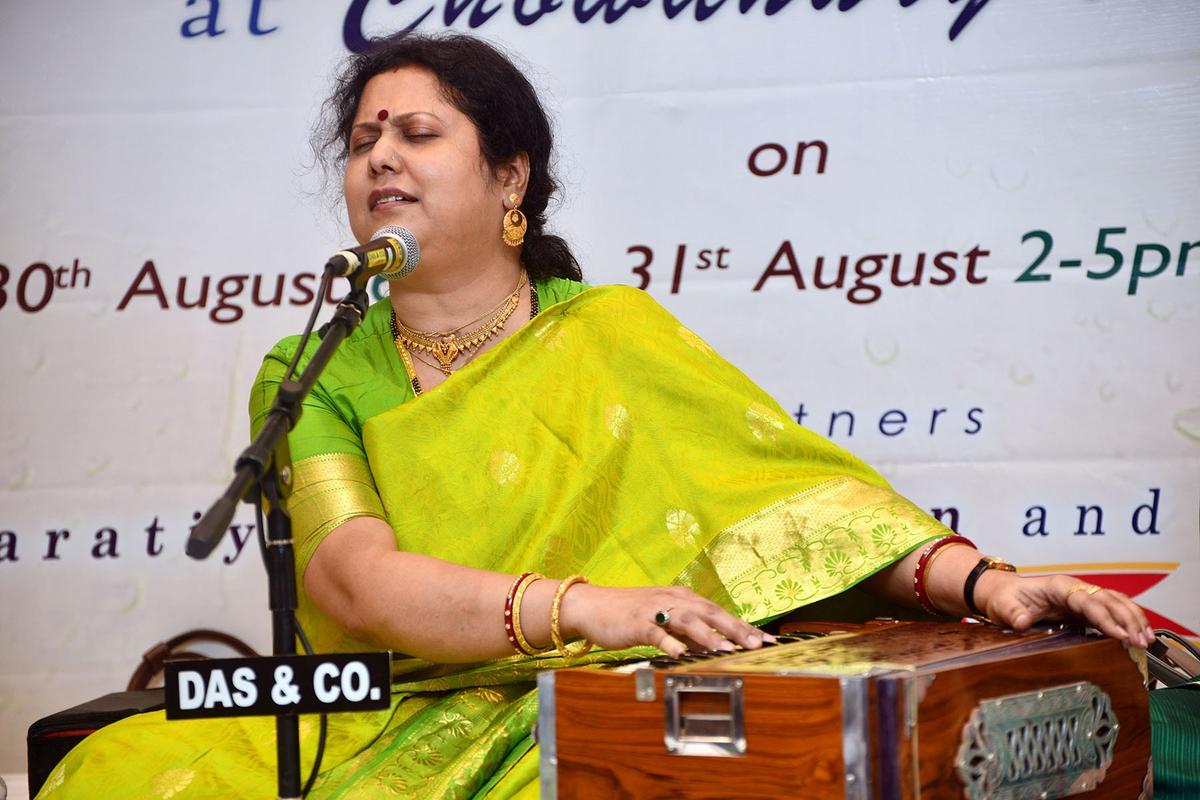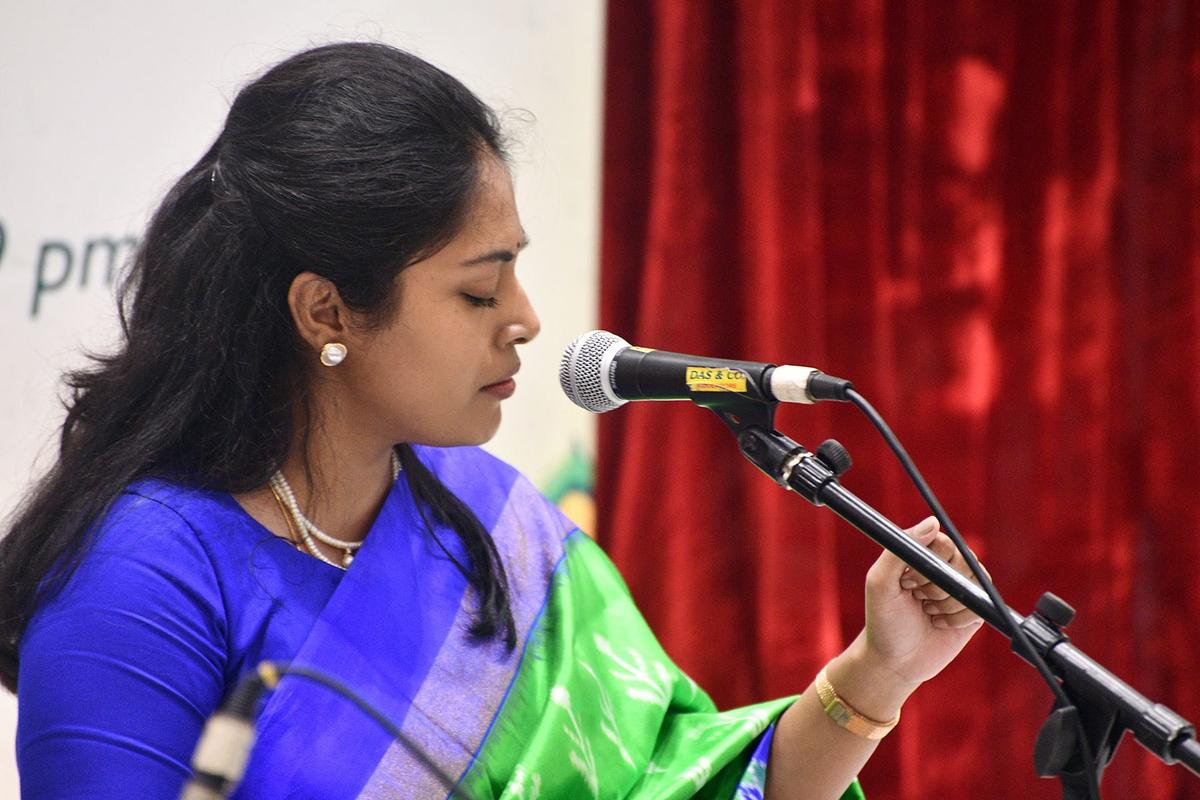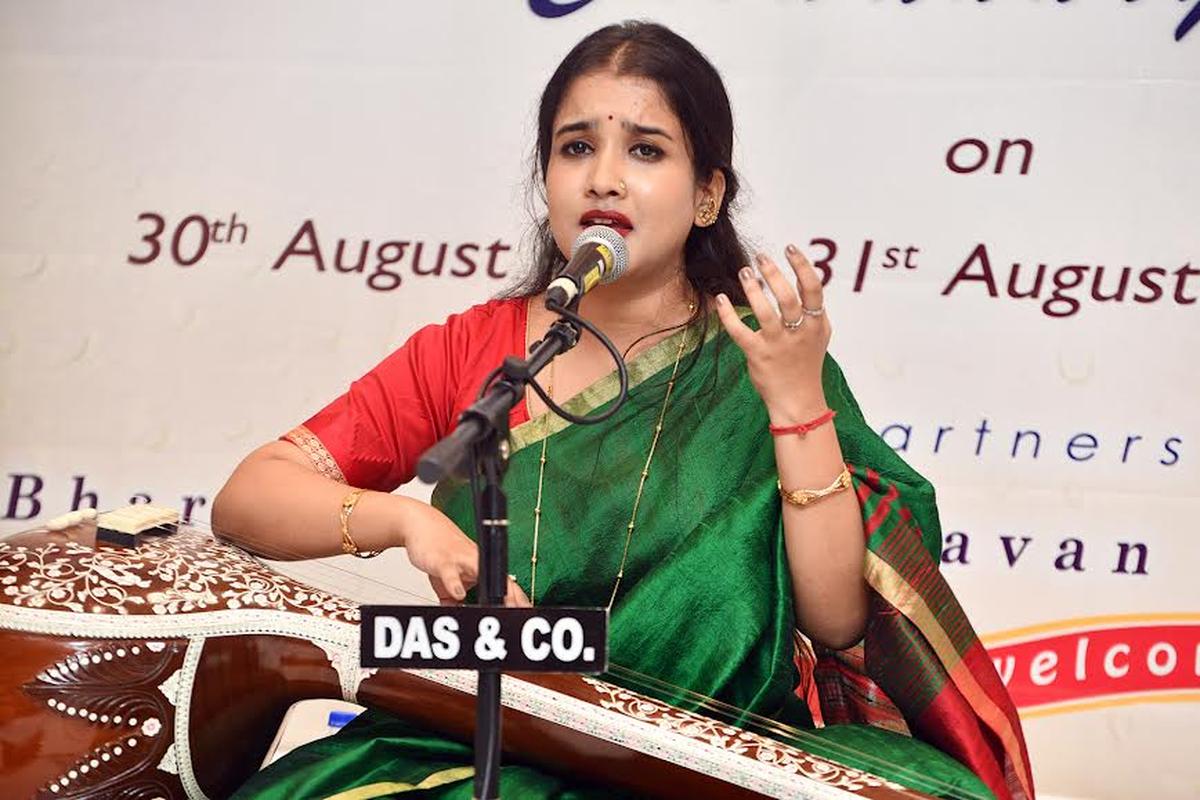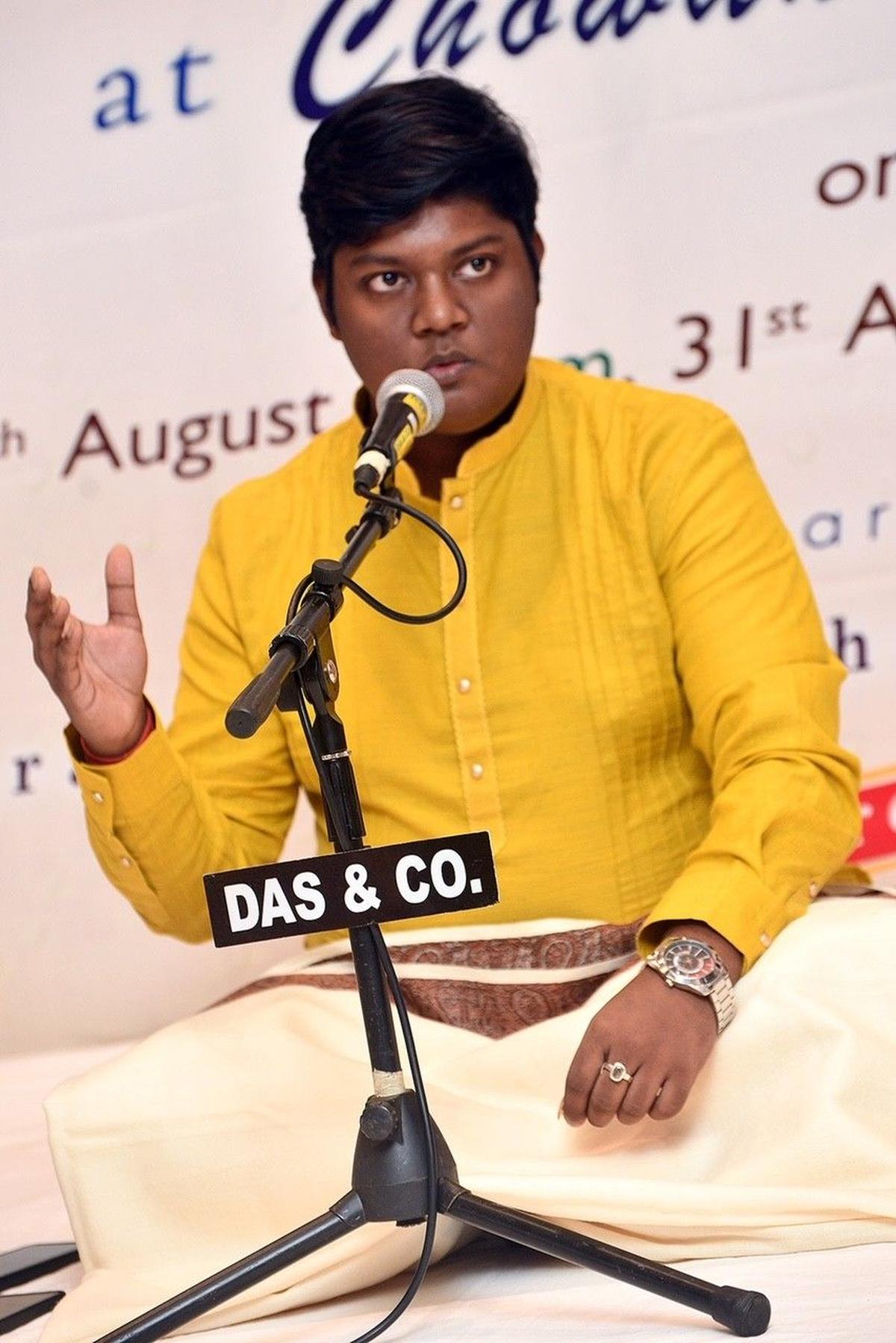At a time when Bengal is screaming ‘We Want Justice’ against the atrocities meted out to women , one could not help but think about the professional women singers, who were stigmatised for centuries as tawaif or baiji till the early 1950s. These real custodians of Hindustani music including the classical dhrupad dhamar, khayal etc, were popularly associated with thumri even after Independence. The decline of thumri was accompanied by the marginalisation of its accomplished practitioners, till the Indian government’s policies remained shackled by the double standards of the Victorian value framework.
The recent ‘Barkha Bahaar’ session, featuring thumri, kajri, jhula and tappa styles , saw many young vocalists turn up as keen participants and audience, as if to avenge the pain and frustration of those Nayikas. Held for two days at the upscale Chowdhury House, it was presented by Aniruddha Chowdhury’s organization, Calcutta Performing Arts Foundation, and assisted by Bharatiya Vidya Bhavan.
In general, thanks to the efforts of legendary musicians such as Girija Shankar Chakraborty, Prasun and Meera Banerjee, Girija Devi, Sipra Bose, and Purnima Chaudhuri, thumri and its allied forms are still practised in Bengal. Nevertheless, many of these forms, with all the riches of the indigenous charm of folk music of Ganga-Yamuna region, are either getting distorted or diluted now.
In 2011, two years before Purnima Chaudhuri’s untimely demise, a series of Purab Anga Gayaki Utsav was held in different Indian cities. It was organised by Vinod Kapur, a music-loving businessman from Grurugram. “VSK Baithak took the initiative to rescue this Gayaki from the dark corner, and bring it back to centre stage by giving this heritage a new name ‘Purab Anga Gayaki’ (PAG); and celebrate it through a series of Baithaks held in Delhi, Varanasi and Kolkata,” says Vinod Kapur, the person behind PAG’s revival. And ‘Barkha Bahar’, a festival to celebrate monsoon, has been taking place in Kolkata, as part of the PAG utsav.
These quarterly Utsavs were organised to assess the selected artistes from all over India and encourage the participants by honouring the top three with ‘Girija Devi Puraskar’. According to Vinod Kapur, he discovered ‘the vocalists of Bengal who have the most appropriate attributes – the sensitivity, quality of voices and femininity to effectively express the nuanced emotion of this Gayaki.’
Interestingly, till 2018 all the awards were won by Bengalis. By then Appaji had left for her heavenly abode. Vinod Kapur was distressed to see that the goldmine of PAG is deprived of gurus who could familiarise the learners with the dialects, literature, lifestyle and culture of Hindi heartland. He, therefore, started the Purab Anga Gayaki Project and entrusted the noble work of disseminating the vidya to several erudite gurus across the country. But, later narrowed it down to Vidushi Manju Sundaram of Benaras and Vidushi Dalia Rahut of Kolkata. They are nurturing the khayal and thumri artistes of different calibre, enabling them to grasp the meaning of a word that carries layers of unexpressed emotions, that bring us closer to our roots, which serves as the lifeline of this rustic yet complex gayaki.
The Event

Abanti Bhattacharjee performing at the Barkha Bahaar series, part of the Purab Anga Gayaki utsav.
| Photo Credit:
Prashant Arora
From these angles, the rustic beauty of Abanti Bhattacharjee’s alluring ‘Piya to maanat nahi’ (Kafi) and the desolate ‘Tarape bin baalam’; and vocalist-sitarist duo Debapriya-Samanwaya’s complex and rare tappa in raag Purvi followed by a lilting jhoola set to Megh, stood out. So was the effortless free flow of Jhumpa Sarkar’s Pilu thumri ‘Saiyan nahi aaye’, followed by a swinging jhoola.
Santa Kundu‘s Kafi-based thumri, with rich lyrics describing the beauty of the divine couple soaked in rain, was soothing and she concluded with a perky Mirzapuri kajri. Bishnupriya Chakrabarty’s traditional thumri was followed by a sohar, congratulating Nand-Yashoda on the arrival of their baby (Krishna). Set to Shivranjani and dipchandi, it turned out to be the only ritualistic song of the fest. She concluded with a brilliant talferta swaying from kaherwa to dadra and back. Dipanjana Bose Chanda took it upwards while rendering a Desh thumri and a rare jhoola set to Rupak. Madhumita Chattopadhyay could not do justice to her melodic thoughts due to a bad throat.
The PAG artistes were accompanied by Ashoke Mukherjee, Pran Gopal Bandopdhyay, Emon Sarkar, Pritam Polley and Aurobinda Bhattacharjee on the tabla, and Debasish Adhikari and young Dilip Biswas on the harmonium. They also offered support to the young performers.

Deblina Ray’s Majh Khamaj bore the stamp of her guru.
| Photo Credit:
Prashant Arora
Young brigade
There were many young artistes who debuted at the PAG utsav. They performed before an audience consisting of very senior musicians, peers and eclectic listeners. The festival opened with Deblina Ray, a disciple of vidushi Suranjana Bose, a scholar with PAG Project under Manju. Deblina sensitively interpreted the delight of union and pangs of separation in two compositions in Majh Khamaj, reminiscent of her Grand Guruma’s style.

Moupali Choudhury embellished her chosen thumri and kajri with excellent kahan.
| Photo Credit:
Prashant Arora
Vidushi Subhra Guha’s singing style came to the fore, when her disciple Moupali Choudhury embellished her chosen thumri and kajri with excellent kahan. Dalia’s young disciple Sagnik Sen, well trained in Patiala’s Khayal Gayaki, sang Desh thumri and a kajri, composed by Appaji. His adherence to PAG’s format of striking a balance between skill and emotions was highly commendable.

Sagnik Sen, disciple of Dalia, is well-trained in Patiala’s Khayal Gayaki.
| Photo Credit:
Prashant Arora
Anjan Majumdar, a maverick, has a unique style. His experiment with Appaji’s ‘Ghir aayi hai’ sounded refreshingly new in Ritisha Mukherjee’s voice. But her ‘Kadar na jaane’ displayed a pleasing voice utilised well in a cusp of old and new. Amrita Dutta, another disciple of Majumdar, sang thumri in Ramdasi Malhar. She could do better by understanding this complex raga first. The following kajri and jhoola with spontaneous phrases were enjoyable.
The Dialogue
The topic was ‘Evolution of Thumri in Bengal’. Moderated by vocalist Supriyo Dutta, it evolved into a confluence of varied perspectives , especially focused on Appaji’s teaching methodology as most of the eminent participants: Guru Dalia Rahut , Manasi Majumdar (Director, Bengal Music College), Suranjana Bose (eminent vocalist and guru), Debapriya Adhikary and Samanwaya Sarkar (celebrated vocal-sitar duo), were groomed by her.
While they highlighted ‘kahan’ as the most important aspect of thumri, or spirituality within the seemingly plain lyrics, Punjab Anga, actually Purab Anga with Patiala nuances, had tappa of Purab Anga that differed greatly from the original tappa of the camel riders of Punjab and Sindh.
Tapasi Ghosh (HOD, Music with Bengal Music College), a disciple of Pandit DT Joshi, explained the salient features of her style of PAG that merges Lucknow, Agra Gharana’s Rangeele aspect with Benares; and Anjan Majumdar, disciple of A Kanan and Malabika Kanan, emphasised the modernisation of the lyrics along with innovative melody of PAG. Those present at the session, led by Pt. Tejendar Narayan Majumdar, opposed this. They also desired for additional session of this kind.
Published – September 20, 2024 05:30 pm IST
